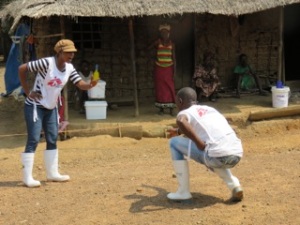Fatmata and Idiatu were smiling, happy with the new clothes we had brought them. Their old ones had been burned, along with the mattress they’d shared with their mother before she tested positive and died from Ebola. Their small, mud-brick house had  been disinfected with chlorine spray by the decontamination team, and infected clothes and mattresses removed and burned. A local NGO was supposed to be bringing replacement mattresses; hopefully they would be here soon. I’d be sure to check up on that and to make sure they had food and water too.
been disinfected with chlorine spray by the decontamination team, and infected clothes and mattresses removed and burned. A local NGO was supposed to be bringing replacement mattresses; hopefully they would be here soon. I’d be sure to check up on that and to make sure they had food and water too.
Moses, the contact tracer for the area had also arrived at the girl’s house. One of a band of scores of dedicated volunteers, he would monitor them, and all other contacts of the positive cases in the surrounding villages, for the 21 day maximum incubation period of the virus. “I come every day to check on them,” he assured me. The family had recently been supplied with thermometers, so were able to monitor their temperature and report any fever, or any other symptoms, to Moses. He would then pass that information to the local Ebola command centre, which would despatch a case investigation officer to the house. If the person met the criteria, an ambulance would be sent to take them to the Ebola management centre for testing.
For now, all four members of this household in the village of Masanga were well and as the outreach team, we’d do everything we could to help them stay that way. Nick, the water and sanitation expert on the team had already supplied them with a home hygiene kit, offering different strengths of chlorine solution for hand-washing, clothes washing and general hygiene. Did they remember how to prepare these? We did a quick check and they passed the test easily.
It was time for the health promotion message. Emma and the team had prepared a drama, concentrating on the transmission of Ebola, staying healthy, and the importance of the early reporting of symptoms. We still don’t know everything about Ebola but it is thought that people who come for testing and treatment in the first stages of the illness, when they have a lower viral load, have a better chance of recovery. This was something we wanted to emphasise, early isolation and treatment could not only save their lives but could also prevent them from infecting their family and spreading the virus further. We soon had a large group gathered round, in front of the house, the team swung into action. Ibrahim did a great display of vomiting and soon the crowd was roaring with laughter. What had they been saying? My mastery of Themne wasn’t up to that but Musa, the hygienist, enlightened me: they’re discussing safe sex, Emma was pretending to refuse sex without a condom. As the virus can stay in semen for up to three months after a patient’s blood is negative, this was an important message to get across.
The peak of the epidemic seems to have passed in Sierra Leone. At the height of it last year, those carrying the virus were taken by ambulance to the only treatment centres in the country, often more than 10 hours away. Many never returned to their villages, and died hundreds of kilometres from their family and friends. The Sierra Leonean people were scared. Superstitious rumours got around that health workers themselves were spreading the disease, maybe even harvesting organs and people became too frightened to get into ambulances, where the chlorine spray used to help control infection was believed to be poisonous.
But now communities have seen people taken by ambulances and return to their villages as survivors, again and again. They are no longer scared of the centres, but realise they offer the means to survive Ebola. In the talks that I gave to communities, the health promotion messages appeared to be understood and accepted. And families mostly – although naturally reluctantly – now call the burial teams when someone dies, instead of following the traditional funeral rites when the family washes the body, which has been one of the primary sources of transmission across West Africa.
So finally, after terrifying months when the disease was spreading like a bush fire, the epidemic appears to be waning. The increased number of available beds has meant that people are admitted more quickly, increasing their own chances of survival while at the same time avoiding spreading the infection to their families. Our management centre has a laboratory working alongside it, so cases can be confirmed within a few hours. And all that, along with extra agencies and volunteers on the ground enabling the system of contact tracing, surveillance and quarantine to be carried out, has helped to slow the outbreak to the lowest levels since last July. But as even one new case can spread the disease to ten or more others, we cannot be complacent. We need to get it down to ZERO.
I left my colleagues continuing with outreach work, making sure every positive case was followed up and properly investigated and continuing to emphasise the basic health promotion messages that really do save lives. There’s still so much to be done in West Africa. As well as controlling the epidemic, there are hundreds if not thousands of orphans who need homes and families, those who disappeared at the peak of the epidemic need to be traced and the food insecurity caused by the epidemic needs to be managed. But at least this seemingly unstoppable behemoth, this viral monster that trails such primeval fear in its wake, is beginning to be brought under control and at last, there is hope.
